
views
Identifying the Tense of the Sentence

Identify different types of present tenses. The present tense describes action being done in the present moment—not future, not past, and not a hypothetical action. The English language has a simple present tense, a present continuous tense, a present perfect tense, and present perfect continuous tense. All indicate action in the present, but differ in their descriptions of how long the action has been taking place. Simple present tense combines a subject + verb. For example: “He writes.” Present continues tense combines a subject + being verb (am, is , are) + verb1 + ing. For Example: “He is writing.” Present perfect tense combines a subject + have/has + verb. For example: “He has written.” Present perfect continuous tense combines subject + has/have + been + verb + ing. Example: “He has been writing.”
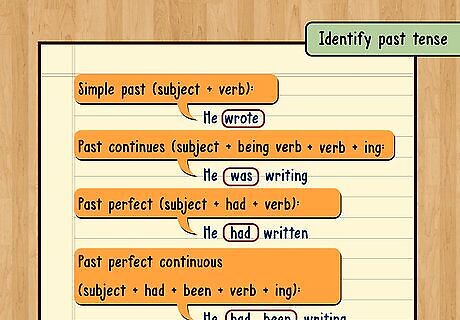
Identify different past tenses. Just as English has multiple present tenses, the language also possesses multiple past tenses. English has a simple past tense, as well as past perfect, past continuous, and past perfect continuous tenses. All past-tense sentences describe something that has already occurred. Simple past tense combines a subject + verb in the sentence. For example: “He wrote.” Past perfect tense combines the subject + had + verb. For example: “He had written.” Past continuous tense combines a subject + being verb (was, were) + verb + ing. For example: “He was writing.” Past perfect continuous tense combines subject + had + been + verb + ing. For example: “He had been writing.”

Identify future tenses. Like present and past tenses, English has multiple forms of the future tense. Each version indicates an action that has not yet occurred—but will occur in the future—and the distinctions between different types of future tense signify the completion or incompletion of the future act. Simple future tense combines a subject + “will” + verb. For example, “He will write.” Future perfect tense combines the subject + “will have” + verb. For example, “He will have written.” Future continuous tense combines a subject + “will” + being verb + verb. For example, “He will be writing.” Future perfect continuous tense combines the subject + “have been” + verb + “ing.” For example, “He will have been writing.”
Converting the Sentence
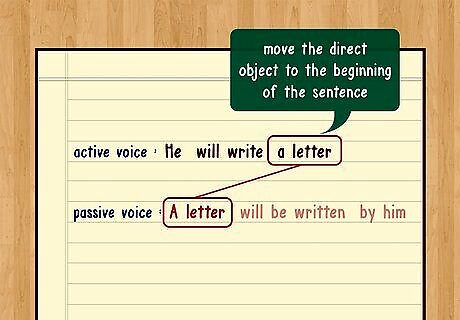
Move the object to the beginning of the sentence. Sentences in the active voice typically begin with the subject and describe the action it does to the direct object. To achieve the passive voice, switch this placement by moving the direct object to the beginning of the sentence. This will highlight the object and its reception of the verb. For example, the sentence “He will write a letter” is in the future tense and active voice. To change this to passive voice, move the direct object to the beginning of the sentence, while keeping the future tense: “A letter will be written by him.”
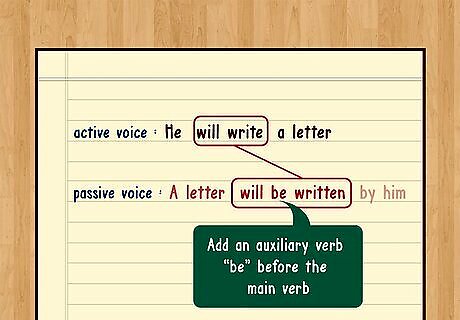
Add an auxiliary verb “be” before the main verb. Adding a “be” verb will make the active verb passive, and highlight the way the direct object was acted upon, rather than how the subject performed that action (as in an active-voice sentence). Depending on the tense of the sentence, being verbs include: “is,” “was,” “will be,” “has been,” etc.

Add the preposition “by” before the subject. The subject (preceded by “by”) should come at the end of the passive-voice sentence. By stating “by” late in the sentence, you’ll add the subject after the direct object and verb have already been clarified. For example: “The stretch of highway was paved by the construction crew.” In cases where the subject (one who does the action) is unknown, you may not be able to add the word “by.” For example, if you have received a letter but do not know who sent it, you would write, “The letter was sent to me on November 1st,” but you would not say by whom it was sent.

Maintain the sentence tense. While switching from active to passive voice, be sure to maintain the correct tense from the original sentence. Keep any auxiliary verbs: verbs which modify the tense of the main verb. Auxiliary verbs include “be,” “can,” “do” and “have.” Read the passive-voice sentence over to yourself to make sure it has the same tense as the former active-voice sentence. For example: Active voice, present tense: The cat kills the mice. Passive voice, present tense: The mice are killed by the cat. Active voice, past continuous tense: Some boys were helping the wounded men. Passive voice, past continuous tense: Wounded men were being helped by some boys. Active voice, future perfect tense: Someone will have stolen my purse. Active voice, future perfect tense: My purse will have been stolen by someone.
Knowing When to Use the Passive Voice
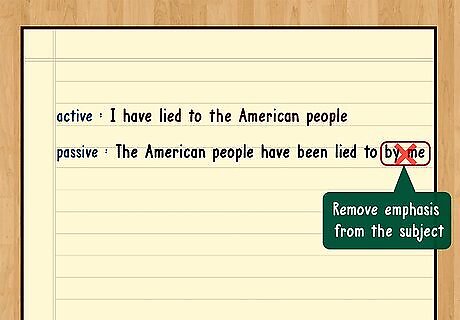
Remove emphasis from the subject. While the passive voice is discouraged in some instances because it can be a sign of weak writing, there are plenty of situations where it’s appropriate. The active voice firmly places the subject—the one who does the action—at the beginning of the clause, passive voice can obscure the subject, focusing instead on the direct object receiving the action. Be careful when removing emphasis from the subject of a sentence, as in some cases it can be seen as confusing to the reader. Passive voice can also remove the subject of a sentence altogether. For example, a politician who says, “I have lied to the American people” may be seen as repentant and forthcoming. If the individual were to say “The American people have been lied to,” they politician would be removing any blame from themselves by phrasing the sentence in the passive voice and removing the subject.
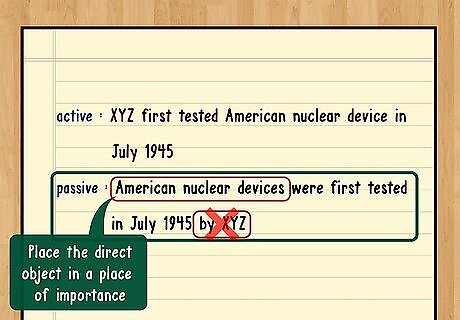
Place the direct object in a place of importance. If the subject of your sentence is relatively unimportant, while the direct object and the action done to it are significant, the passive voice can be used. Writers often use the passive voice when describing an event or occurrence in which the direct object or action is more relevant than the subject of the sentence. For example, the sentence “American nuclear devices were first tested in July 1945” places the emphasis on the nuclear testing and leaves the specific researchers anonymous.
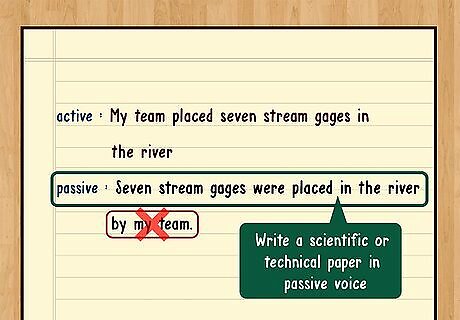
Writing a scientific or technical paper in passive voice. In science writing, the passive voice is used to indicate objectivity and detachment from the topic or investigation of the paper. Within a scientific paper, sections describing “Methods,” “Materials,” or “Processes” are nearly always written in passive voice. For example, instead of writing “My team placed seven stream gages in the river,” you would write, “Seven stream gages were placed in the river.” Here the passive voice lends anonymity to the action: anyone can replicate the experiment by repeating the same procedures. By using the passive voice, you’re arguing that the results can be replicated regardless of which scientists perform the actions.




















Comments
0 comment